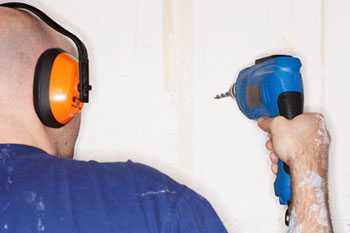NOISE AND HEARING LOSS PREVENTION
Risk Factors

Not only differences in exposure conditions affects risk. Certain biological factors – such as gender, age, race/ethnicity, genetics, and general health issues – can influence a worker’s susceptibility to the effects of noise. Since it is not possible to measure the exact susceptibility of any individual worker, all workers must be well-protected. In order to understand why the prevalence and degree of noise-induced hearing loss can vary so much within a group and among groups several factors have been studied.
NIOSH research is currently focused on:
- Improving our understanding of the risk criteria associated with impulsive noise, and how best to measure impulsive events. An early NIOSH study (Dunn et al. Hearing loss in the chinchilla from impact and continuous noise exposure. J. Acoust. Soc. Am., 90(1), (1991) demonstrated that exposure to impulse noise produced a greater magnitude of hearing loss in animals than an equivalent exposure to continuous noise As exposure assessment is a critical component of assessing the risk from exposures, NIOSH developed a measurement and analysis system for accurately capturing and monitoring exposure to impulsive noise. NIOSH contributed to the evaluation of the performance of hearing protection for impulse noise exposures (Murphy et al. Measurement of impulse peak insertion loss for four hearing protection devices in field conditions, Int J Audiol. 2012 Feb; 51(0 1): S31–S42) and is currently evaluating metrics for assessing the differential effects of impulse noise versus continuous noise of the same equivalent energy.
- Improving our understanding of risk factors associated with ethnicity and aging. Surveillance is vital to
occupational hearing loss (OHL)
prevention. It makes possible the establishment of estimates for the prevalence and incidence of hearing loss within various industries. Surveillance also enables NIOSH to identify high-risk groups, guide prevention and research efforts, and evaluate the success or failure of interventions. Without surveillance data, progress in hearing loss prevention efforts cannot be quantified, nor the need for improvement in these efforts. Since 1997, NIOSH has supported the audiometric component of the National Health and Nutrition Examination Survey (NHANES). The NHANES data have been utilized in the updated International Standards Organization acoustic standard, ISO 1999:2013. ISO 1999 allows estimation of expected hearing loss due to varying intensities and durations of noise exposure during employment. ISO 1999 provides hearing practitioners with normative data against which a particular exposed population can be compared. The NHANES data have been used to update the hearing tables for unscreened normal populations and expand the tables to include data at 8000 Hz. Finally, the NHANES data will be used to develop updated age-correction tables for OSHA. The original age-correction tables were developed from a data set that was small and predominantly male and Caucasian. The new data set will include representative samples of males and females and should have sufficient statistical power to separate known effects due to ethnicity.
- Understanding hearing loss due to ototoxicants (such as solvents, heavy metals, and asphyxiates) alone or in combination with noise. Ototoxic chemicals can also affect hearing. Some of them can cause hearing loss even without simultaneous excessive noise exposure; others interact with noise to increase the risk to hearing. Workplace chemicals that can pose a risk to hearing include:
- Organic solvents – e.g., toluene, styrene, xylene, ethylbenzene, trichloroethylene
- Heavy metals – e.g., mercury, lead, trimethyltin
- Asphyxiants – e.g., carbon monoxide, hydrogen cyanide
- Pesticides
-
NIOSH ( Criteria document ) and the American College of Occupational and Environmental Medicine American College of Occupational and Environmental Medicine (ACOEM evidence-based statement: Noise-induced hearing loss. J Occup Environ Med 2003;45:579-581) both recommend that hearing loss prevention programs take chemical exposures into account when monitoring hazards, assessing hearing and controlling exposures. These recommendations do not include specific information on exposure levels of concern, which can be found elsewhere:
- European Agency for Safety and Health, Combined exposure to Noise and Ototoxic Substances.
- The Nordic Expert Group for Criteria Documentation of Health Risks from Chemicals, Occupational exposure to chemicals and hearing impairment.
- Department of the Army, Army Hearing Program, Pamphlet 40-501.
- U.S. Army Public Health Command: Occupational Ototoxins (Ear Poisons) and Hearing Loss - Fact Sheet 51-002-0713
- Page last reviewed: November 16, 2016
- Page last updated: November 16, 2016
- Content source:
- National Institute for Occupational Safety and Health Division of Applied Research and Technology



 ShareCompartir
ShareCompartir